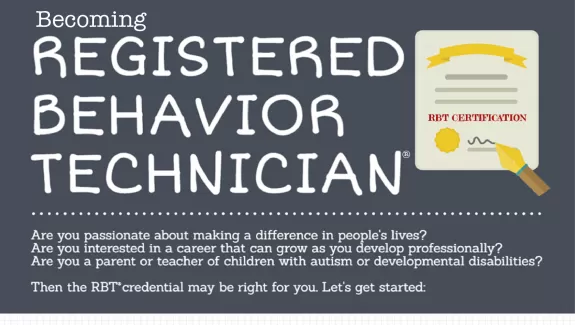
Guiding the Role of the RBT®
How Supervisors Can Positively Impact Progress and Culture
Your most important role as a supervisor is to get results for your clients, offering them optimal opportunities to improve their quality of life. As experts in the science of behavior analysis, you can get results by maximizing and supporting your most important asset—your people. As direct service providers, your Registered Behavior Technicians (RBTs)® spend the most time with clients and do the most teaching. Ultimately, it is up to you to be a quality supervisor by fostering an environment where you can get discretionary effort from your RBTs®.
Spectrum of RBTs®
To produce change, you must consider the individuals you will be targeting for change. A supervisor could conceptualize this as a spectrum of the motivations and goals of RBTs®. It’s important to look at your RBTs® as individuals, just as you would a client, and consider where they are in their education, their next steps, and how to reinforce their efforts.
- Just a Job
One end of the spectrum, we have those for whom this is just a job. They are not necessarily less motivated, but they are not looking to advance in the field, at least not immediately; they may be exploring the field to see if it’s a fit for them. - Advance in the Field
On the other end, we have those who are looking to advance in the field. They may be passionate about Clinical Applied Behavior Analysis (ABA). They may have been in the field a long time or just starting out, or they have other motivations and interests. In fact, they may become your colleague in the future. - Passionate RBT®
In between these two, we have those who are passionate but do not intend to advance. Many of them love working with the populations we work with, and we know as you move up in a role, you spend more time doing administrative work and less time with the clients. In a similar vein, many teachers don’t want to go into administration. - Each of these groups are transient and not necessarily permanent, as needs and wants change. Sometimes, if you provide quality supervision, you may inspire passion. On another extreme, you could contribute to burnout. This all leads to my main point: providing quality supervision.
Quality Supervision
Quality supervision entails a few strategies that you should focus on, which touch on your skills as a leader, a communicator, and an agent for behavior change. Quality supervision is an essential element to creating culture change in your organization. When you’ve provided quality supervision, you will have more skilled RBTs®, more time on your hands, and better client outcomes. As a supervisor, you are looked to as a model for behavior, and what you do may be imitated. You are constantly modeling behavior, so be mindful of the environment you are creating, and consider how you talk to therapists. When you are present, this behavior may be reflected in the praise you provide to therapists or the strategies you implement while teaching clients. When you create an environment that models supportive behavior, others will support each other as well. If you are seldom present, you have little opportunity to model behavior and thereby have limited capacity to create a supportive environment. Lack of support in such an intensive job makes it that much more difficult, and this risks burnout. Many of us have either directly encountered burnout or seen someone burn out. Burnout is a serious issue that impacts everyone in this field; I recommend reading Burnout: Recognition and Prevention for strategies on preventing and recognizing burnout. I would especially consider the suggestions on ways to reduce burnout and how you as a supervisor could create an environment that supports these strategies. As a supervisor, you are a part of the work environment, and you have control over whether or not that environment contributes to burnout. When you can prevent and reduce burnout, you will have more skilled, happy, dedicated therapists who can provide better client outcomes; thereby, it is essential that you provide quality supervision.
 To provide quality supervision, first, it may help to know at which standards to hold your RBTs®. At the bare minimum, they are providing a much-needed, essential service to clients by fulfilling their programs with integrity. At the next level, you are teaching your therapists to grow from a good therapist to a great therapist. This may apply more to the second and third types of RBTs®, but any RBT® will find that as they improve their skills and have more tools in their kit, everything runs more smoothly. As they progress, your clients will get excellent outcomes, and you can trust your therapists to tackle all sorts of clients and programs and get creative in their job. Thirdly, at another level, you could assign additional responsibilities, delegating supportive tasks and leadership roles. This is, in part, for the third type of RBT® or any individual interested in taking on more responsibility and maybe those who want activities other than one-on-one client hours.
To provide quality supervision, first, it may help to know at which standards to hold your RBTs®. At the bare minimum, they are providing a much-needed, essential service to clients by fulfilling their programs with integrity. At the next level, you are teaching your therapists to grow from a good therapist to a great therapist. This may apply more to the second and third types of RBTs®, but any RBT® will find that as they improve their skills and have more tools in their kit, everything runs more smoothly. As they progress, your clients will get excellent outcomes, and you can trust your therapists to tackle all sorts of clients and programs and get creative in their job. Thirdly, at another level, you could assign additional responsibilities, delegating supportive tasks and leadership roles. This is, in part, for the third type of RBT® or any individual interested in taking on more responsibility and maybe those who want activities other than one-on-one client hours.
To implement any of this, however, you need to provide an adequate number of supervision hours. This may be constraining in some environments because you can’t do this in a volume clinic, as you wouldn’t be present enough to observe for treatment integrity, to provide necessary basic supports, or to inspire any discretionary effort from your RBTs®. These environments are risky for burnout, as RBTs® become devalued as little more than babysitters. Additionally, you wouldn’t be able to delegate in a volume clinic; if you aren’t providing quality supervision, you aren’t able to train the tasks and provide feedback. This all takes away one of your most valuable assets: time.
Coaching
In their book, Deliberate Coaching: A Toolbox for Accelerating Teacher Performance, Nicholas Weatherly and Paul Gavoni write, “Teachers must be the star of the show, and school leaders should seek to make them shine.” Coaching is essential for culture change and for bringing your therapists to that next level. Coaching differs from training in that this is ongoing teaching that is used to build and refine a skill set and can be best done in the natural environment, just like any other aspect of ABA. When you are on the floor providing your quality hours, these are learning opportunities for the therapists. These ongoing teaching opportunities are best done as an individualized approach, where you would educate to the level of your learner. In this case, your learner is an RBT®. If they are new, they need to know the difference between running a listener-responding program and an imitation program. If they’ve shown a good understanding of the principles of ABA and can catch naturalistic opportunities, it may help them to understand skill progression in clients so the therapist can be on their toes and ready to reinforce and shape natural occurrences of successive behavior. For an insightful, detailed, yet quick read on effective coaching practices, I recommend the aforementioned Deliberate Coaching: A Toolbox for Accelerating Teacher Performance by Weatherly and Gavoni.

Additionally, outside of natural opportunities, you could consider regular, such as monthly, training sessions to bring them to a higher level. These training sessions could be structured in a lecture and collaborative format. For example, learning about different available prompting strategies could be done in lecture format and would not only allow them to consider when they accidentally prompt, such as with glances and gestures, but also allow them to consider novel, effective prompt approaches that would work for their own and each other’s clients. Also, these training sessions could be learning opportunities for some of the more seasoned RBTs®, sometimes your lead RBTs®, and new BCBAs to work on their teaching skills in a group setting.
A skilled RBT® is valuable in many contexts. As an RBT® learns more about ABA and programming skills, they can take advantage of spontaneous opportunities. They’ll know the right context to practice a social program or a listener-responding program. They’ll be able to make split-second decisions. They’ll be able to identify the right moments to shape behavior. They can better tell when behaviors are escalating and how to best de-escalate the situation. They’ll understand the idiosyncrasies of their own behavior and identify how it occasions behavior.
Feedback
 One of the most helpful tools in coaching is feedback. Feedback is often the easiest and cheapest intervention for behavior change, making it a good tool in your pocket. It is so important that it is included in the Ethical Compliance Code (see section 5.06). However, feedback can come in different forms and functions, depending on how you use it. Feedback can be corrective and provided as antecedents (alternative behaviors are suggested before an opportunity), or positively as consequences, (successes are acknowledged). This is valuable for anyone doing anything new. There are many ways to approach providing feedback, such as a checklist that evaluates their treatment integrity; this will allow everyone to ensure the most success and to determine objectively areas of focus and of success. I recommend reviewing Giving Good Feedback for a general take on feedback, and taking Aubrey Daniels’ CE Course for a more detailed understanding of feedback. This job is stressful; your support and understanding can make it less so.
One of the most helpful tools in coaching is feedback. Feedback is often the easiest and cheapest intervention for behavior change, making it a good tool in your pocket. It is so important that it is included in the Ethical Compliance Code (see section 5.06). However, feedback can come in different forms and functions, depending on how you use it. Feedback can be corrective and provided as antecedents (alternative behaviors are suggested before an opportunity), or positively as consequences, (successes are acknowledged). This is valuable for anyone doing anything new. There are many ways to approach providing feedback, such as a checklist that evaluates their treatment integrity; this will allow everyone to ensure the most success and to determine objectively areas of focus and of success. I recommend reviewing Giving Good Feedback for a general take on feedback, and taking Aubrey Daniels’ CE Course for a more detailed understanding of feedback. This job is stressful; your support and understanding can make it less so.
I like to argue that feedback should move like a two-way street. Supervisors also need to receive feedback on how they’re doing. This can be naturalistic, where the supervisor self-monitors and attends to key information: How is this RBT® reacting to my input? They may give you feedback, but it’s difficult giving feedback to your boss. However, these are key opportunities where someone is communicating with you on how your behavior affects them. This is a learning moment for you, and it’s important to take it well and acknowledge their feedback. Otherwise, if there is a problem, and they haven’t told you, you may not notice it, and you may end up with a culture problem. Once you attend to the idiosyncrasies of your own behavior, you can adjust it.
Reinforcement
Ultimately, the most important element for behavior change is reinforcement. Feedback touches on this, in a way, but the role of reinforcement can’t be emphasized enough. RBTs® don’t always know what they’re doing wrong or right. By noticing their successes and acknowledging what they do right you may be reinforcing their behavior. If you fail to do this, their effective behavior could go on extinction. When people aren’t recognized for the work they do, the rate of their performance will decrease.
 The importance of providing reinforcement is not only that you are teaching new behaviors rather than extinguishing them, but also that you are pairing yourself with reinforcement. When you do the opposite, you are focusing on poor performance behavior and only approaching when there is a problem. In what may be a familiar story to many of us, I once heard of an RBT® say about a supervisor, “We know we are doing a good job when we don’t see her.” If you consistently reprimand, institute a penalty, or a punishment, you establish yourself as a conditioned aversive. Whether you are associated with reinforcement is something that you can observe in RBT® approaches, mands for information (“How do I do this?”), and communicating any difficulties or concerns, they’re having.
The importance of providing reinforcement is not only that you are teaching new behaviors rather than extinguishing them, but also that you are pairing yourself with reinforcement. When you do the opposite, you are focusing on poor performance behavior and only approaching when there is a problem. In what may be a familiar story to many of us, I once heard of an RBT® say about a supervisor, “We know we are doing a good job when we don’t see her.” If you consistently reprimand, institute a penalty, or a punishment, you establish yourself as a conditioned aversive. Whether you are associated with reinforcement is something that you can observe in RBT® approaches, mands for information (“How do I do this?”), and communicating any difficulties or concerns, they’re having.
With reinforcement, you are also improving your work environment and culture. When you provide praise, it models the behavior for others to do the same. Consider the balance of 4 positive interactions to 1 negative interaction. This ratio of reinforcement can be applied to any aspect of the work environment, such as the supervisor, coworkers, and clients. Having that ratio—at minimum—constitutes a positive work environment. Many times, we fall into the trap of putting the most skilled workers with the most difficult clients. This makes sense in many situations, as we certainly don’t want to do this with a brand-new therapist. However, you have to pay attention to this and ensure you are not providing more work contingent on hard work, as this can be punishing. The environment needs to provide more reinforcers than punishers.
Delegating and Collaborating
Supervisors can make the most of their time and their RBTs® by delegating tasks. This can support continuing education for those who are looking to grow and have experience. Tasks you delegate are all things for which you need to teach, coach, provide feedback, and provide supervision. When RBTs® learn these delegated tasks, your job is made much easier and allows you to have more time.

Consider the value of the tasks you delegate, how learning the tasks will improve the RBT® as a clinician and a future supervisor, and how it will impact client outcomes. Any and all of these tasks should be done, as authorized, under your supervision; you must teach them and provide feedback on the tasks you delegate to them. Not all RBTs® are yet qualified to do these tasks, so your supervision is key here if you wish to delegate these tasks (see The RBT® 2nd Edition Task List, and the BACB Compliance Code Item 5.03). Additionally, you may tailor these tasks so they are appropriate for each RBT’s® interests and motivations, considering the spectrum of RBTs®. They can look at graphs for you and report on progress weekly so you can determine if interventions need adjusting. This will save you time and ensure that programs are effective. This also, in turn, familiarizes the RBT® with how data-based decisions are made. They can draft a program or task analysis you assign, which familiarizes your RBT® with programming and skill progression. Since this one is so nuanced to each client, you can fade out directives depending on their knowledge of the client, such as particular prompting strategies that you know to work with the client. An RBT® who will one day sit for the exam can help with insurance forms, thus familiarizing them with requirements they’ll need to fulfill in the future and sparing you a time-consuming task. They can do parent training, sitting in on meetings with you, making data sheets for the parents, and teaching skills to the parents. When you have your RBT® do this, they can do so on a weekly basis in as little as ten minutes to teach a skill the parent can use at home such as basic reinforcement. This can be beneficial for an RBT® who is passionate to excel beyond minimum competence, regardless of whether or not they plan to sit for the exam.
When you’ve delegated responsibilities and activities, your skilled RBTs® could also train others, as authorized and under your supervision. For those seeking further education, being able to teach direct-care providers is an important skill. For those at any skill level, each RBT® can provide useful information on different clients, provide support on different skill sets they are strong on and serve as models to new trainees. By effectively training the trainers, you are creating an environment where people learn from each other by bringing different perspectives and strategies to the table.
Additionally, to get the most out of your RBTs® and your interactions with them, collaborating with them is a helpful tool. The RBTs® spend the most time with the client and know the client very well. They are your most valuable source of information about the client. However, you have the expertise, experience, and education in ABA. Every client is different. They have different reinforcers, different effective prompting strategies, and different skill sets. As a supervisor, you will find a need to look to your RBT® for a lot of this information. Collaborating with service providers ensures that the client will get the highest quality of services.
Entrusting your RBTs® and shaping them upward will allow them, and you, to provide a wide range of procedures and with the ability to modify procedures on the spot as needed. Rather than rely on an inflexible, fixed, template-based approach for all of your clients, you can employ progressive ABA (consider Leaf et al., 2015). As a science, ABA is inherently progressive, and as a specified discipline, we understand that each individual is different and should be taught in a flexible approach. For this to be effective, your RBT® will need to understand the basic principles of ABA and the various uses and purposes of procedures. If your therapist is only able to implement procedures in a fixed way, that is the fault of teaching and the quality of the learning environment. In these situations, the therapist will be unequipped for a client for whom these template procedures don’t work and will struggle to adapt to changes in the field. The prompting procedures you use with one client may not be as effective on another. The learning histories a client has will influence the effectiveness of certain strategies. When you provide coaching and training in necessary foundational concepts in ABA, the therapists will have the components to take a creative approach and recombine these processes in generalized contexts.
In conclusion, when you provide quality supervision, you create a positive impact on your culture, your people, your clients, and yourself. You will get dedicated, passionate people who are invested in the quality of their work and the progress of their clients. Your clients will get the best outcomes with skilled therapists and excellent program oversight. Finally, your job will be easier when you’ve delegated responsibilities and can trust your RBTs® to do a good job.



